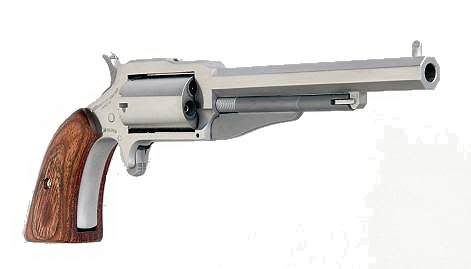This is as good a time as any to address the .22 Magnum cartridge. Some regard the .22 Mag as a weak little cartridge, suitable only for ground squirrels and the like. That is a mistake. I have a very high regard for the little magnum. It offers very good penetration on flesh, and hits as hard as many larger calibers that are regarded as good choices to solve distasteful social encounters. I often recommend the .22 Magnum for a concealed carry or home protection gun for those who, for whatever reason, cannot handle the recoil of more powerful handguns. With very little recoil and muzzle rise, a good .22 Magnum can easily be used by most anyone to accurately place several shots rather quickly on target. Looking at the video demonstration by clicking the top picture to the right, the light recoil and easy controllability is readily apparent. In a fixed breach pistol such as the Automag II, the .22 Magnum really shines, giving higher velocities, and therefore more power, than revolvers of like size; this is attributable to the Automag's lack of the barrel/cylinder gap of the revolver design.
To illustrate this, I compared the velocities of the Automag II with those of two of my favorite .22 magnum revolvers; a Ruger Single Six Hunter with a seven and one-half inch barrel, and a Taurus Model 941 with a five inch barrel, using a few different .22 Magnum cartridges. The results are shown in the chart below. Velocities are listed in feet-per-second (fps). Bullet weights are listed in grains. The chronograph testing took place using a PACT chronograph, with an air temperature of 53 degrees Fahrenheit.
Ammunition Bullet Weight Ruger 7-1/2 inch Taurus 5 inch AutoMag 6 inch
Winchester Supreme JHP 34 1506 1563 1650
CCI Maxi-Mag TNT 30 1519 1542 1671
CCI Maxi-Mag +V 30 1516 1596 1680
Winchester Dynapoint 45 1105 1204 1256
PMC Predator JHP 40 1215 1280 1412
Federal Game-Shok JHP 50 1035 1085 1235
As can be seen in the chart, the Automag II clearly displayed higher velocities than did the two revolvers, sometimes as much as a 200 fps advantage, with most loads giving about a 150 fps edge to the AMT over the long-barreled Ruger. The most impressive gains were shown with the heavier bullets. The chart shows higher velocities for the five inch Taurus than it does for the longer-barreled Ruger. This is no misprint, but is a clear indication of the relation between a good, tight barrel/cylinder gap and high velocity. Of course, the AMT with no barrel/cylinder gap outperformed both.






